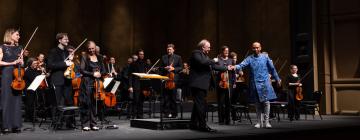
Fashion-forward they may be, but the Eroica’s powerhouse performers (pianist Erika Nickrenz, violinist Susie Park, cellist Sara Sant’Ambrogio) also have plenty of musical chops to back up their glamour appeal. Everything about this group teems with passion, from the heroic connotations of the ensemble’s name to the exuberance that characterizes its approach.
Taken to extremes, assessments of the ensemble’s outsize image can border on caricature. (Witness the comment several years ago from a Tucson Citizen journalist who impudently declared, “They look like supermodels and they play like demons on crack.”) But at the end of the day it’s all about the music, and in programs Feb. 28 in Walnut Creek and March 1 in Palo Alto, courtesy of Chamber Music San Francisco, Eroica will be offering up a compelling selection of repertory, blending vigorous youth with sober reflectiveness.
Beethoven’s youthful Piano Trio in C Minor, Op. 1, No. 3, premiered in 1793 (and composed under Joseph Haydn’s tutelage), hints at the formal expansiveness and brilliant expressive contrasts to come in his later music. Still, this captivating trio failed to convince Haydn, who asserted that it “would not be quickly or easily understood,” nor would it be “favorably received by the public.” The composer evidently disagreed, esteeming the work enough to refashion it into his later String Quintet in C Minor, Op. 104.
Joan Tower’s For Daniel, composed in 2004 on the death of her nephew, presents a powerful, elegiac contrast. Two thematic ideas — repeated dissonant chords, and intricate solo piano interludes — anchor a maelstrom of a piece, laden with deeply personal resonances. As Tower herself has said, “The 17-minute trio conveys the complex emotions of someone facing a terminal, long-range illness. The hope, joy, depression, pain, deep turmoil and occasional serenity are in constant juxtaposition in this work — as they were throughout the last years of Daniel’s life. As the end approaches, so does the intensity. In my work, this intensity is expressed in a fast and loud way. Daniel was probably more accepting. May he now rest in peace.”
Eroica’s final selection, Brahms’ Piano Trio in B Major, Op. 8, presents another case of a composer revisiting his earlier work. Brahms published this piece as a teenager in 1854, revising and then republishing it nearly four decades later, in 1891. In doing so, the composer claimed he “did not provide [the piece] with a wig, but just combed and arranged its hair a little.” Nevertheless, the new version was more of a haircut then he let on — considerably shortened, with fewer themes and a simplified overall structure. Of all Brahms’ surviving output, this trio is the only piece to exist in two published editions, though the later one is almost always the version performed nowadays.

